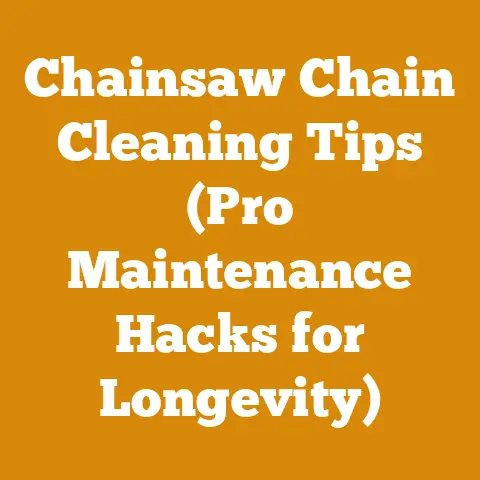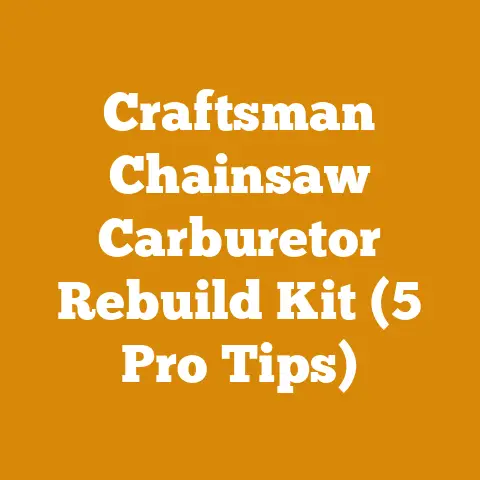Steel Weed Eater Head Guide (7 Pro Tips for Tough Wood Cutting)
The rough, splintered feel of aged oak beneath my calloused hands. The smooth, almost silken touch of freshly cut maple. The resinous stickiness of pine clinging to my gloves. These textures are the language of the woods, a language I’ve been fluent in for decades. And while chainsaws usually take center stage in my world, today, I’m diving into a different kind of wood-cutting tool: the steel weed eater head. You might be surprised, but these little powerhouses can be incredibly effective for certain tasks, especially when you need precision and maneuverability. I’m here to share my experiences and pro tips for using them safely and efficiently.
Steel Weed Eater Head Guide: 7 Pro Tips for Tough Wood Cutting
For years, I’ve relied on various tools for wood processing, from heavy-duty chainsaws to precision axes. But sometimes, the job calls for something lighter, more agile. That’s where the steel weed eater head comes in. It’s not a replacement for a chainsaw, but it’s a valuable addition to my arsenal. I’ve learned a lot through trial and error, and I’m eager to share what I know.
1. Understanding the Steel Weed Eater Head
First, let’s clarify what we’re talking about. A steel weed eater head replaces the standard nylon string on a weed eater (also known as a string trimmer). These heads typically feature metal blades or chains designed for cutting thicker vegetation, including small branches and woody stems.
- Types of Steel Heads: I’ve used several types, including those with fixed blades, pivoting blades, and even mini-chains. Each has its strengths and weaknesses. Fixed blades are good for aggressive cutting, while pivoting blades offer more safety and versatility.
- Compatibility: Not all weed eaters are compatible with steel heads. Check your weed eater’s manual to ensure it’s rated for metal blades. Using an incompatible head can damage the trimmer or be downright dangerous. I recommend sticking to heads specifically designed for your model.
- Safety First: These heads are significantly more dangerous than nylon string. Always wear appropriate safety gear, including eye protection, hearing protection, gloves, and sturdy boots. I even use chaps sometimes, depending on the wood I’m cutting.
Takeaway: Choose the right steel head for your weed eater and prioritize safety above all else.
2. Assessing Your Wood-Cutting Needs
Before you even think about attaching a steel head, consider what kind of wood cutting you’ll be doing. These tools are best suited for specific tasks, not general-purpose wood processing.
- Ideal Applications: I find steel weed eater heads most useful for:
- Cutting small branches (under 2 inches in diameter): Perfect for clearing brush and creating walking paths.
- Removing unwanted saplings: Easier to maneuver around obstacles than a chainsaw.
- Trimming hedges and shrubs with woody stems: Provides a cleaner cut than nylon string.
- Light pruning: Good for reaching awkward spots.
- Limitations: Don’t expect to fell trees or split logs with a steel weed eater head. It’s simply not designed for that kind of work. Overusing it can lead to damage and frustration. I once tried to cut a 4-inch branch with one, and it took forever and nearly burnt out the motor.
- Wood Type Matters: Softer woods like pine and willow are easier to cut than hardwoods like oak and maple. Adjust your technique and expectations accordingly.
Takeaway: Steel weed eater heads excel at light-duty wood cutting tasks. Know their limitations.
3. Preparing Your Weed Eater
Proper preparation is crucial for both performance and safety. A well-maintained weed eater will handle the steel head much better.
- Inspection: Before each use, I thoroughly inspect my weed eater. Check for loose screws, frayed wires, and any signs of damage. Pay special attention to the trimmer head attachment point.
- Fuel and Lubrication: Ensure your weed eater has fresh fuel (if gas-powered) or a fully charged battery (if electric). Lubricate any moving parts as recommended by the manufacturer. I use a fuel stabilizer in my gas weed eater to prevent starting issues.
- Head Installation: Follow the manufacturer’s instructions for installing the steel head. Make sure it’s securely attached and properly aligned. A loose head can vibrate excessively and be dangerous. I always double-check the tightness of the retaining nut.
- Throttle Control: Practice using the throttle with the steel head attached but not engaged with any wood. Get a feel for the power and how the head responds.
Takeaway: A well-maintained and properly prepared weed eater is essential for safe and effective steel head operation.
4. Mastering the Cutting Technique
Using a steel weed eater head effectively requires a specific technique. It’s not as simple as just swinging it around.
- Controlled Movements: Avoid wild, sweeping motions. Instead, use short, controlled cuts. Let the blades do the work. I find it’s best to approach the wood at a slight angle.
- Cutting Direction: Cut from the outside in. This prevents the blades from binding and reduces the risk of kickback. I always make sure I have a clear line of sight and a stable stance.
- Blade Angle: Experiment with different blade angles to find what works best for the wood you’re cutting. A steeper angle is usually better for thicker branches.
- Avoid Overloading: Don’t try to cut too much wood at once. Overloading the blades can stall the engine or motor and potentially damage the weed eater. Let the tool dictate the pace.
- Rest Periods: Take frequent breaks to prevent overheating and fatigue. This is especially important during hot weather. I usually work in 20-minute intervals with 10-minute breaks.
Takeaway: Controlled movements, proper cutting direction, and avoiding overloading are key to effective steel head operation.
5. Safety Protocols: A Non-Negotiable
I cannot stress enough the importance of safety when using a steel weed eater head. It’s a powerful tool that can cause serious injury if mishandled.
- Personal Protective Equipment (PPE): Always wear:
- Eye Protection: Safety glasses or a face shield are essential to protect your eyes from flying debris.
- Hearing Protection: The noise from a weed eater with a steel head can be damaging to your hearing.
- Gloves: Protect your hands from cuts and abrasions.
- Sturdy Boots: Provide ankle support and protect your feet.
- Long Pants and Sleeves: Offer additional protection from flying debris.
- Chaps (Optional): If you’re cutting thicker branches or working in dense brush, chaps can provide extra protection for your legs.
- Clear the Area: Before you start cutting, clear the area of any obstacles, including rocks, branches, and people. Establish a safety zone around yourself. I usually mark off a 15-foot radius.
- Awareness: Be aware of your surroundings at all times. Watch out for hidden hazards, such as roots or holes.
- Kickback: Be prepared for kickback, which can occur when the blades bind or hit a hard object. Maintain a firm grip on the weed eater and keep your body balanced. I always stand slightly to the side of the cutting path to avoid being hit by kickback.
- Never Modify: Never modify the steel head or the weed eater in any way. This can compromise its safety and performance.
Takeaway: Safety is paramount. Always wear PPE, clear the area, and be aware of your surroundings.
6. Maintenance and Storage
Proper maintenance will prolong the life of your steel weed eater head and ensure its continued safe operation.
- Cleaning: After each use, clean the steel head with a wire brush to remove any debris. I also use a solvent to remove any sap or resin buildup.
- Sharpening: Keep the blades sharp. Dull blades are less efficient and more likely to bind. Use a file or grinder to sharpen the blades as needed. Follow the manufacturer’s instructions for sharpening.
- Lubrication: Lubricate any moving parts of the steel head as recommended by the manufacturer. This will help prevent rust and corrosion.
- Storage: Store the steel head in a dry place, away from moisture and extreme temperatures. I keep mine in a toolbox with my other gardening tools.
- Blade Inspection: Regularly inspect the blades for cracks, chips, or other damage. Replace damaged blades immediately.
Takeaway: Regular cleaning, sharpening, lubrication, and proper storage will keep your steel weed eater head in top condition.
7. Troubleshooting Common Issues
Even with proper preparation and technique, you may encounter some common issues when using a steel weed eater head.
- Blade Binding: If the blades bind, stop the weed eater immediately. Remove the head from the wood and inspect it for any obstructions. Try cutting from a different angle or using a sharper blade.
- Engine Stalling: If the engine stalls, it may be due to overloading the blades, a clogged air filter, or a fuel problem. Check the air filter and fuel lines. If the problem persists, consult a qualified mechanic. I once had a wasp nest in my air filter!
- Excessive Vibration: Excessive vibration can be caused by a loose head, a damaged blade, or an unbalanced engine. Check the head and blades for damage. If the problem persists, consult a qualified mechanic.
- Overheating: Overheating can be caused by prolonged use, a clogged air filter, or a lack of lubrication. Take frequent breaks and ensure the air filter is clean.
Takeaway: Knowing how to troubleshoot common issues will help you keep your steel weed eater head running smoothly.
Beyond the Basics: Advanced Tips and Considerations
After years of using steel weed eater heads, I’ve picked up a few advanced tips that can further enhance your experience.
Understanding Wood Density
The density of the wood you’re cutting significantly impacts the performance of the steel weed eater head. As I mentioned earlier, softwoods like pine and cedar are much easier to cut than hardwoods like oak and maple. Here’s a quick breakdown:
- Softwoods: Generally less dense and easier to cut. They tend to produce more sawdust and require less force.
- Hardwoods: Denser and more challenging to cut. They require sharper blades and more patience.
I’ve found that for hardwoods, it’s best to use a steel head with more aggressive blades or even a mini-chain. For softwoods, a simpler blade design will often suffice.
Utilizing Different Blade Types
The market offers a variety of steel weed eater head blades, each designed for specific purposes.
- Fixed Blades: Offer aggressive cutting power and are ideal for thicker branches. However, they can be more prone to kickback.
- Pivoting Blades: Provide more safety and versatility. They’re less likely to bind and can be used for a wider range of tasks.
- Mini-Chains: Offer chainsaw-like cutting performance in a smaller package. They’re great for cutting thicker branches and even small saplings.
I recommend experimenting with different blade types to find what works best for your needs. I keep a selection of blades on hand so I can choose the right one for the job.
Optimizing Cutting Angle and Speed
The angle at which you approach the wood and the speed at which you move the weed eater can significantly impact cutting efficiency.
- Angle: As I mentioned earlier, a slight angle is often best. This allows the blades to bite into the wood more effectively.
- Speed: Don’t force the tool. Let the blades do the work. Too much speed can cause the blades to bind or the engine to stall.
I’ve found that a slow, steady approach is usually the most effective.
Dealing with Tougher Wood
Sometimes, you’ll encounter wood that’s particularly tough to cut, even with a steel weed eater head. Here are a few tips for dealing with these situations:
- Sharpen Blades: Ensure your blades are razor-sharp. Dull blades will struggle to cut through tough wood.
- Use a More Aggressive Blade: Consider switching to a blade with a more aggressive design.
- Apply Lubricant: Applying a small amount of lubricant to the blades can help them glide through the wood more easily. I use a spray-on silicone lubricant.
- Take Smaller Bites: Don’t try to cut too much wood at once. Take smaller, more controlled bites.
- Consider a Different Tool: If the wood is simply too tough for the steel weed eater head, it may be time to switch to a chainsaw or other more powerful tool.
Extending Blade Life
Steel weed eater head blades can wear out over time, especially if you’re cutting tough wood or working in abrasive conditions. Here are a few tips for extending blade life:
- Avoid Hitting Rocks and Other Hard Objects: This can damage the blades and reduce their lifespan.
- Clean Blades Regularly: Remove any debris buildup, which can accelerate wear.
- Sharpen Blades Regularly: Keeping the blades sharp will reduce the amount of force required to cut the wood, which can also extend blade life.
- Store Blades Properly: Store the blades in a dry place, away from moisture and extreme temperatures.
Adapting to Different Environments
The environment in which you’re working can also impact the performance of the steel weed eater head.
- Dry Conditions: Dry wood can be more difficult to cut than green wood. Consider applying a small amount of water to the wood to make it easier to cut.
- Wet Conditions: Wet wood can be slippery, so be extra careful when using the steel weed eater head. Ensure you have a good grip on the tool and wear slip-resistant boots.
- Dusty Conditions: Dusty conditions can clog the air filter and reduce engine performance. Clean the air filter regularly.
Ethical and Environmental Considerations
As a wood processor, I believe it’s important to consider the ethical and environmental implications of our work. When using a steel weed eater head, keep the following in mind:
- Avoid Cutting Endangered Species: Be aware of any endangered or protected plant species in your area and avoid cutting them.
- Minimize Environmental Impact: Avoid disturbing the soil or damaging surrounding vegetation.
- Dispose of Waste Properly: Dispose of any waste materials, such as cut branches, in a responsible manner. I often chip the smaller branches and use them as mulch.
- Promote Sustainable Forestry Practices: Support sustainable forestry practices that ensure the long-term health of our forests.
Case Studies: Real-World Applications of Steel Weed Eater Heads
To illustrate the versatility and effectiveness of steel weed eater heads, let me share a few case studies from my own experience.
Case Study 1: Clearing Brush for a Walking Path
I was tasked with clearing brush and creating a walking path through a wooded area. The area was overgrown with small trees, shrubs, and thick vines. Using a chainsaw would have been overkill and potentially dangerous due to the uneven terrain.
I opted for a steel weed eater head with pivoting blades. This allowed me to easily maneuver around obstacles and cut through the thick vegetation. The pivoting blades also reduced the risk of kickback.
Over the course of two days, I was able to clear a 5-foot-wide path through the area. The steel weed eater head proved to be an invaluable tool for this project.
Case Study 2: Removing Unwanted Saplings
I had a client who wanted to remove a number of unwanted saplings from their property. The saplings were growing close to a fence and other structures, making it difficult to use a chainsaw.
I used a steel weed eater head with fixed blades to cut the saplings at ground level. The fixed blades provided the aggressive cutting power needed to quickly and efficiently remove the saplings.
The client was very pleased with the results.
Case Study 3: Trimming Hedges with Woody Stems
I was hired to trim a hedge that had become overgrown and had developed thick, woody stems. Using a standard hedge trimmer would have been difficult and time-consuming.
I used a steel weed eater head with mini-chains to trim the hedge. The mini-chains provided the cutting power needed to easily cut through the woody stems.
The hedge was trimmed to a uniform shape, and the client was very happy with the outcome.
Conclusion: A Valuable Tool in the Right Hands
The steel weed eater head is not a replacement for a chainsaw or other heavy-duty wood-cutting tools. However, it can be a valuable addition to your arsenal, especially for light-duty tasks such as clearing brush, removing saplings, and trimming hedges.
By following the pro tips and safety protocols outlined in this guide, you can safely and effectively use a steel weed eater head to tackle a variety of wood-cutting projects. Remember to choose the right head for your needs, maintain your equipment properly, and always prioritize safety.
I hope this guide has been helpful. Now, get out there and put these tips into practice! Just remember to listen to the wood, respect the power of the tool, and always prioritize safety. Happy cutting!






